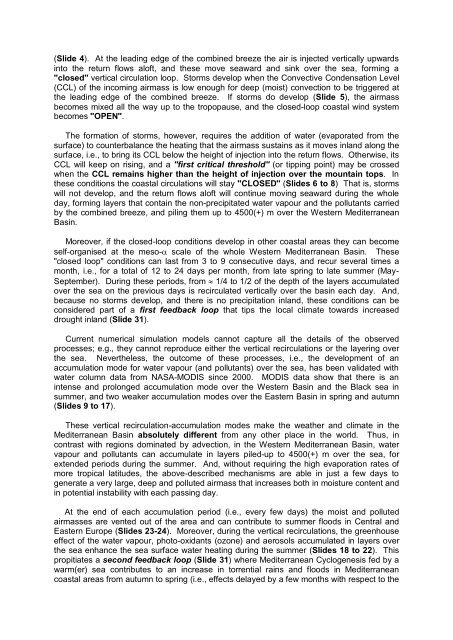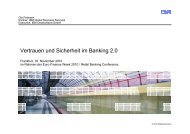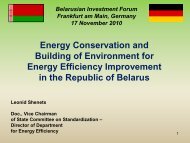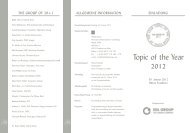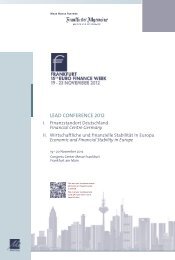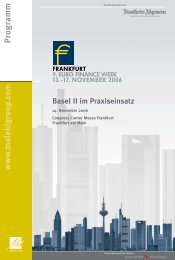The Two European Hydrological Cycles:
The Two European Hydrological Cycles:
The Two European Hydrological Cycles:
Create successful ePaper yourself
Turn your PDF publications into a flip-book with our unique Google optimized e-Paper software.
(Slide 4). At the leading edge of the combined breeze the air is injected vertically upwards<br />
into the return flows aloft, and these move seaward and sink over the sea, forming a<br />
"closed" vertical circulation loop. Storms develop when the Convective Condensation Level<br />
(CCL) of the incoming airmass is low enough for deep (moist) convection to be triggered at<br />
the leading edge of the combined breeze. If storms do develop (Slide 5), the airmass<br />
becomes mixed all the way up to the tropopause, and the closed-loop coastal wind system<br />
becomes "OPEN".<br />
<strong>The</strong> formation of storms, however, requires the addition of water (evaporated from the<br />
surface) to counterbalance the heating that the airmass sustains as it moves inland along the<br />
surface, i.e., to bring its CCL below the height of injection into the return flows. Otherwise, its<br />
CCL will keep on rising, and a "first critical threshold" (or tipping point) may be crossed<br />
when the CCL remains higher than the height of injection over the mountain tops. In<br />
these conditions the coastal circulations will stay "CLOSED" (Slides 6 to 8) That is, storms<br />
will not develop, and the return flows aloft will continue moving seaward during the whole<br />
day, forming layers that contain the non-precipitated water vapour and the pollutants carried<br />
by the combined breeze, and piling them up to 4500(+) m over the Western Mediterranean<br />
Basin.<br />
Moreover, if the closed-loop conditions develop in other coastal areas they can become<br />
self-organised at the meso-� scale of the whole Western Mediterranean Basin. <strong>The</strong>se<br />
"closed loop" conditions can last from 3 to 9 consecutive days, and recur several times a<br />
month, i.e., for a total of 12 to 24 days per month, from late spring to late summer (May-<br />
September). During these periods, from � 1/4 to 1/2 of the depth of the layers accumulated<br />
over the sea on the previous days is recirculated vertically over the basin each day. And,<br />
because no storms develop, and there is no precipitation inland, these conditions can be<br />
considered part of a first feedback loop that tips the local climate towards increased<br />
drought inland (Slide 31).<br />
Current numerical simulation models cannot capture all the details of the observed<br />
processes; e.g., they cannot reproduce either the vertical recirculations or the layering over<br />
the sea. Nevertheless, the outcome of these processes, i.e., the development of an<br />
accumulation mode for water vapour (and pollutants) over the sea, has been validated with<br />
water column data from NASA-MODIS since 2000. MODIS data show that there is an<br />
intense and prolonged accumulation mode over the Western Basin and the Black sea in<br />
summer, and two weaker accumulation modes over the Eastern Basin in spring and autumn<br />
(Slides 9 to 17).<br />
<strong>The</strong>se vertical recirculation-accumulation modes make the weather and climate in the<br />
Mediterranean Basin absolutely different from any other place in the world. Thus, in<br />
contrast with regions dominated by advection, in the Western Mediterranean Basin, water<br />
vapour and pollutants can accumulate in layers piled-up to 4500(+) m over the sea, for<br />
extended periods during the summer. And, without requiring the high evaporation rates of<br />
more tropical latitudes, the above-described mechanisms are able in just a few days to<br />
generate a very large, deep and polluted airmass that increases both in moisture content and<br />
in potential instability with each passing day.<br />
At the end of each accumulation period (i.e., every few days) the moist and polluted<br />
airmasses are vented out of the area and can contribute to summer floods in Central and<br />
Eastern Europe (Slides 23-24). Moreover, during the vertical recirculations, the greenhouse<br />
effect of the water vapour, photo-oxidants (ozone) and aerosols accumulated in layers over<br />
the sea enhance the sea surface water heating during the summer (Slides 18 to 22). This<br />
propitiates a second feedback loop (Slide 31) where Mediterranean Cyclogenesis fed by a<br />
warm(er) sea contributes to an increase in torrential rains and floods in Mediterranean<br />
coastal areas from autumn to spring (i.e., effects delayed by a few months with respect to the


